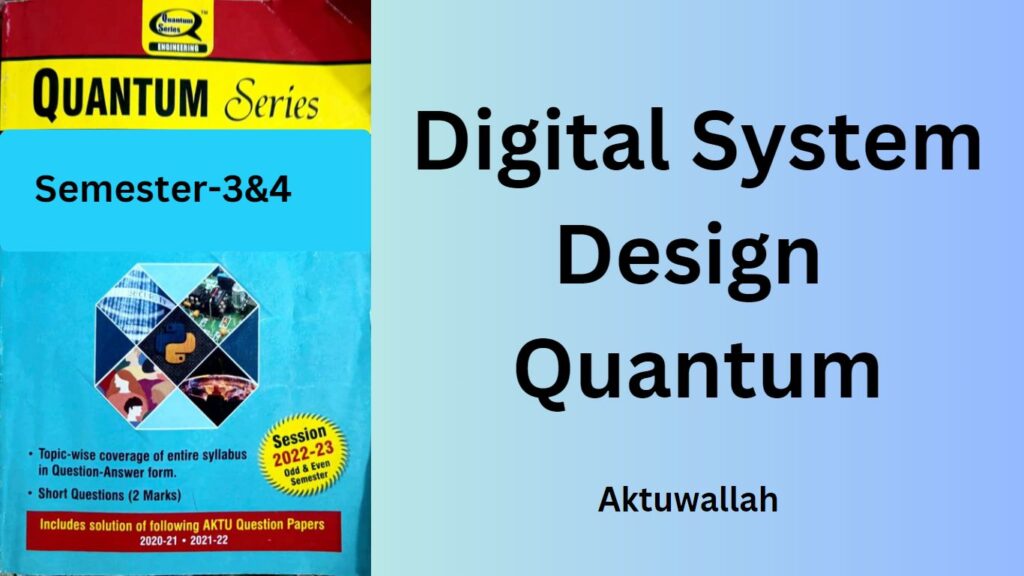Download Digital Electronics Quantum PDF For Aktu B-tech 2nd Year:
Digital electronics is a fundamental subject in the field of engineering, particularly for students pursuing a Bachelor of Technology (B-Tech) degree. This article aims to provide a concise yet comprehensive overview of key topics in Digital Electronics Quantum pdf , specifically tailored for AKTU B-Tech 2nd-year students. Whether you’re looking to strengthen your understanding or preparing for an exam, this article will serve as a valuable resource. So let’s dive into the exciting world of digital electronics!
How to download Digital Electronics Quantum PDF for free?
It is simple to download this pdf file, just click at the given link:
GET PDF
Download DSD Handwritten Notes PDF. Click Here
To download other quantum pdf: Download pdf
Download handwritten notes of all subjects: Download pdf
Key topics covered in Digital Electronics Quantum PDF:
1. Introduction to Digital Electronics
In this section, we will explore the basic concepts and principles of digital electronics. We will define digital signals, discuss binary representation, and introduce important terminologies such as bits, bytes, and digital circuits.
2. Number Systems and Codes
Understanding different number systems and codes is crucial in digital electronics. We will cover the binary, decimal, octal, and hexadecimal number systems. Additionally, we will discuss various codes, including the ASCII code and BCD (Binary Coded Decimal).
3. Logic Gates and Boolean Algebra
Logic gates form the building blocks of digital circuits. We will explain the functioning of basic logic gates such as AND, OR, NOT, NAND, and NOR. Furthermore, we will introduce Boolean algebra, which is essential for designing and analyzing digital circuits.
4. Combinational Circuits
Combinational circuits combine logic gates to perform specific functions without any memory elements. We will discuss multiplexers, decoders, encoders, and adders, among other important combinational circuit components.
5. Sequential Circuits
Unlike combinational circuits, sequential circuits incorporate memory elements to store and process information. We will explore flip-flops, shift registers, and counters, highlighting their applications in sequential circuit design.
6. Flip-Flops and Latches
Flip-flops and latches are fundamental components of sequential circuits. We will examine various types of flip-flops, including SR flip-flops, D flip-flops, JK flip-flops, and T flip-flops. Understanding their characteristics and timing diagrams is crucial for proper circuit design.
7. Counters and Registers
Counters and registers are widely used in digital electronics. We will delve into different types of counters, such as up counters, down counters, and modulus counters. Additionally, we will discuss parallel and serial data transfer using registers.
8. Digital Logic Families
Digital logic families define the characteristics and performance of integrated circuits. We will provide an overview of popular logic families such as TTL (Transistor-Transistor Logic) and CMOS (Complementary Metal-Oxide-Semiconductor), highlighting their advantages and limitations.
9. Analog to Digital and Digital to Analog Converters
Analog to digital converters (ADC) and digital to analog converters (DAC) play a vital role in interfacing the digital and analog domains. We will explain the working principles and various types of ADCs and DACs, including parallel and serial conversion techniques.
10. Memory Devices
Memory devices are essential components of digital systems. We will explore different types of memory, such as ROM (Read-Only Memory), RAM (Random Access Memory), and cache memory. Additionally, we will discuss memory organization and access techniques.
11. Programmable Logic Devices
Programmable logic devices (PLDs) offer flexibility in designing digital circuits. We will introduce PLDs, including Programmable Logic Arrays (PLAs) and Complex Programmable Logic Devices (CPLDs). We will also touch upon Field Programmable Gate Arrays (FPGAs) and their applications.
Conclusion
In conclusion, digital electronics is a fascinating field that underpins modern technology. This article has provided a comprehensive overview of key topics in digital electronics, covering everything from basic concepts to advanced applications. By studying these topics diligently, AKTU B-Tech 2nd-year students can develop a strong foundation in digital electronics, setting the stage for a successful engineering career.
1 thought on “Download Digital Electronics Quantum PDF”